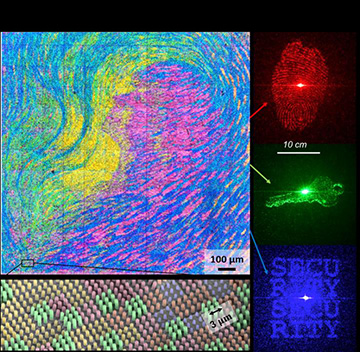
A six-color holographic print made from layers of nanopatterned pixels projects three different holograms when exposed to light from a laser pointer. [Image: SUTD]
Researchers from the Singapore University of Technology and Design (SUTD) have demonstrated a method for embedding multiple holograms into a color print using nanostructured pixels that can control the phase and amplitude of light (Nat. Commun., doi: 10.1038/s41467-018-07808-4). Under ambient light, the holographic color prints appear as a color image. However, when the prints are exposed to red, green or blue light from a hand-held laser pointer, they project different red, green or blue holograms on a far-field screen. The SUTD team says that these optical devices could be used to enhance the security of printed documents, including printed currency, credit cards and passports.
Foiling forgers with nanostructured pixels
The most common forms of document security use phase-modulating holograms or amplitude-tuning microscopic color prints. However, forgers are getting more skilled at reproducing these anti-counterfeit marks. The SUTD team, led by associate professor Joel Yang, developed and demonstrated a potentially enhanced method for optical security that uses nanostructured pixels that can modulate both the phase and amplitude of light. When combined into a multilayered patterned array, these pixels form color prints that can project up to three holographic images when exposed to different colors of light.
The top layer of the holographic color print contains amplitude-modulating pixels that produce a standard color image in ambient (incident) light and act as color filters that direct red, green or blue (coherent) light to the holographic layers below. The researchers were able to pack three holograms into one print because light passes through the print parallel to the pixels, allowing the pixels to individually block light or allow it through, depending on its wavelength, to one of the three underlying phase-specific holographic layers.
Fabricating and demonstrating holographic color prints
The researchers fabricated the holographic color prints from a single dielectric polymer using a unique algorithm and a femtosecond laser writer. The algorithm combines the pixel-array pattern for the top color-image layer with the pixel-array patterns for the underlying holographic layers. The individual pixels are composed of an array of pillars, which acts as a color filter, arranged on top of a square-shaped block, which acts as a phase plate. The researchers optimized the height of the pillar arrays and the thickness of the phase-plate blocks to give the best selectivity for red, green and blue light.
In their proof-of-concept demonstration, the researchers used Luigi Russolo’s 1910 painting “Perfume” to create a holographic color print. In ambient light, they observed a six-color rendering of the painting. When they directed a red, green or blue laser pointer at the print, they observed projected holograms of a red thumbprint, a green key or the word “SECURITY” in blue letters on a far-field screen. The holograms were visible across a 30-degree range of illumination angles, which the team says is convenient for hand-held viewing. The hologram projections were also visible when produced with a low-power laser pointer.
The SUTD team says that the ease with which these holographic projections can be made and the complexity of their structure make the holographic color prints potential tools for enhanced optical security in anti-counterfeiting applications. And because they are fabricated from a single dielectric material, they could be easily and affordably mass-produced via nano-imprint lithography.
